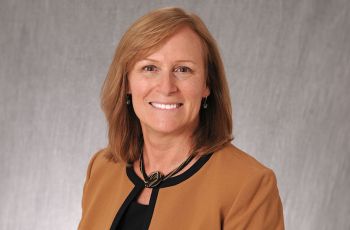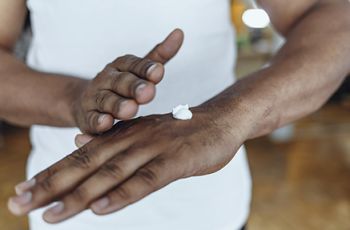
Best practices for safely and effectively identifying and removing urinary tract stones were among the highlights of this year’s Dr. Harry C. Miller Visiting Professorship, Symposium, and Luncheon, March 14. The second annual event featured Glenn Preminger, M.D., chief of the Division of Urologic Surgery, Duke University Medical Center as this year’s visiting professor.
Preminger, a noted expert in minimally invasive management of urinary tract stones, gave two addresses during the day-long event. Between each grand rounds presentation, residents from GW’s School of Medicine and Health Sciences Department of Urology offered case presentations.
In his opening remarks, Preminger, an awarding-winning clinician recognized by institutions such as the British Association of Urological Surgeons and the American Urological Association, discussed “Imagine Recommendations for the Stone Former,” describing best practices to improve “specificity and sensitivity” while minimizing radiation exposure for both the patient and the physicians. Radiologists, explained Preminger, use the term ALARA: As Low As Reasonably Achievable as the concept of trying to limit the amount of radiation, not only for the patient, but also for the physicians who are treating that patient.
Radiation exposure, he said to the audience of residents and alumni, is something that should be particularly important for surgeons as well as their patients. “When I’m in the OR, I’m trying to stand behind the resident or behind my fellow,” joked Preminger. He added, however, that radiation exposure for a physician is no laughing matter. Every precaution, from lead table drapes to protective eyewear, is an important consideration because over time, even the lowest doses of radiation can add up. “Since I’ve been standing in the OR for 30 years, I’m concerned about radiation exposure.”
Prior to the opening Visiting Professorship address, and again after Preminger’s initial remarks, residents took to the stage for case presentations, giving them an opportunity to get invaluable feedback from the minimally invasive specialist and director of the metabolic evaluation and preventative medical treatment at the Duke Comprehensive Kidney Stone Center. Topics ranged from pregnant patients with stones to a 12-year-old pediatric patient who came to the ED with a large urinary tract stone, after having had two previous surgical procedures to remove stones.
In the case of the pediatric patient, Preminger told the resident, “With this young boy, who has a big stone like that, the first thing I am thinking is that he had a cystine stone [a build up of excess amino acid] ... It’s not unusual to have a parent or even a sibling with a calcium stone, and then have a young patient suffering from a cystine stone.”
Preminger explained that such patients are probably suffering from Cystinuria, a commonly inherited disorder. In such cases, added Preminger, more immediate actions need to be taken. “In a patient this age who has already had two surgical procedures and now has had a return to stones, it’s clear that fluids and potassium citrate alone aren’t going to cut it. You have to lower cystine concentration.”
Following the case presentations, Preminger delivered the second of his talks, “Surgical Treatment of Urolithiasis: An Evidence-Based Approach.” In those remarks, Preminger addressed the surgical management of stones and the evolving best-practices for their removal. He detailed the influence new endoscopic tools, such as basket devices, stone cones, and gel back-stops, have had on the surgical techniques used in his practice. The role for shock wave lithotripsy therapy, he said, is waning for the management of stones. Ureteroscopy, added Preminger, has become first-line therapy for most of his distal and mid-ureterol stone patients. The use of digital endoscopy will continue to expand, he said, explaining that the addition of enhanced tools will improve the stone removal techniques and patient morbidity.
The American Urological Association is in the process of releasing a new set of guidelines for both renal and ureterol stones. “I believe that those guidelines (due out later this year) will suggest that ‘yes, there is still a role for shock wave therapy, but with the newer and less invasive endoscopic techniques available, we will see an increasing role for ureteroscopy and percutaneous stone removal.’ ”
Following the discussions, the group adjourned to the Weingold Executive Conference Center for the Dr. Harry C. Miller Visiting Professor Luncheon, where William Lloyd Glover Jr., M.D., RESD ’74, FACS, received this year’s School of Medicine and Health Sciences Distinguished Urology Alumni Award.
After completing his urologic residency at SMHS in 1974, Glover has been in private practice in Fairfax, Virginia, and has continued at the university, currently serving as a clinical professor of urology. Glover is responsible for introducing the Chinese “no-scalpel” technique for vasectomies at GW, and he pioneered microsurgical vasectomy reversal, endourology, transrectal ultrasound prostate needle biopsy techniques, and noninvasive or minimally invasive techniques in urology such as microwave therapy for benign obstruction and cryoablation for prostatic and renal carcinoma.
“Dr. Glover is an exceptional practicing physician characterized by intellectual curiosity and a drive to find better techniques for his patients,” said Miller, adding that Glover “would study and critically evaluate new urological techniques” and after critical evaluation “incorporate these into his practice and share them with other urologists in the community.”


